You’ve probably come across the term “Pavé diamonds,” and with its unique spelling, it’s natural to assume that it’s something fancy and intriguing. However, those assumptions may or may not be accurate. Today, we’re here to separate fact from rumor and provide you with an entertaining and informative guide to Pavé diamonds. We’ll delve into what they are, unravel their uniqueness, and present you with all the essential information you need to know. Get ready for an exciting exploration into the world of Pavé diamonds!
DESIGN YOUR OWN ENGAGEMENT RING: START WITH A SETTING OR START WITH A DIAMOND. IT’S REALLY UP TO YOU!

What Are Pavé Diamonds?
Let’s begin by defining pavé diamonds and then delve into the specifics:
Pavé diamonds are a type of ring setting where multiple small diamonds are closely placed together, creating a continuous line or “pavement” of glitter on the ring. This setting technique is popular and has gained recognition over time.
When we refer to Pavé diamonds, we’re describing the arrangement of small diamonds clustered closely together, forming a pavement-like pattern on the ring. This setting style requires careful precision, as the diamonds are typically small. It is this meticulous craftsmanship that adds to their allure and sense of luxury, which we’ll explore further in this article.
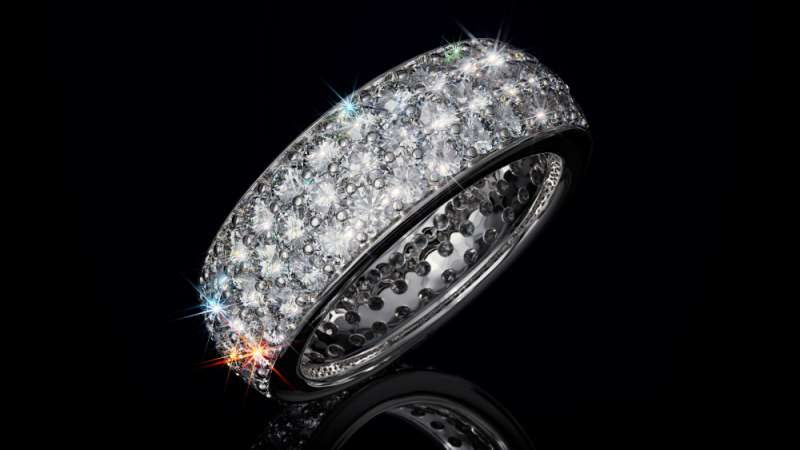
Where Do Pavé Diamonds Come From?
Pavé settings have a rich history that spans several centuries, with some of the most notable designs dating back to the Georgian period. During this era, rings, lockets, brooches, earrings, and other precious items featured pavé-set diamonds and gemstones, including turquoise.
The process of creating a pavé setting involves carving a hole or divot in the material and carefully fitting the tiny gemstone into it. To secure the stone in place, a metal tool is used to create small beads or prongs that press over the stone.
There are various styles and techniques employed to achieve the pavé setting, resulting in slightly different appearances. The essence of pavé is to create a diamond or gemstone outline or achieve overall surface coverage with stones.
These insightful quotes shed light on the origins and evolution of the pavé setting as we know it today. While the initial concept had a specific meaning, the history of this setting reveals the emergence of new variations that gained popularity over time.
In the upcoming sections, we will explore these different variations of the pavé setting, so stay tuned to learn more!
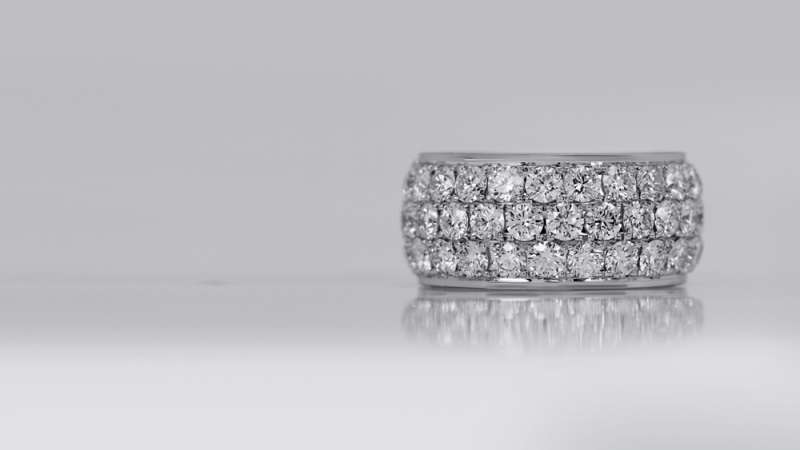
How Big Are Pavé Diamonds And Why?
Pavé diamonds are typically not large in size. The nature of this setting involves using numerous small diamonds closely arranged to create the appearance of a pavement of tiny diamonds. Individually, these small diamonds may weigh around 0.1 or 0.2 carats each, but when combined, they can add up to one or two carats.
If you prefer larger diamonds weighing around 0.4 or 0.5 carats, you will either need to pay a higher price or settle for a smaller number of diamonds in your pavé setting.
Since the pavé setting already provides a dazzling array of small diamonds, the centerpiece (if present) can be slightly smaller. In comparison to these 0.1-carat diamonds, anything between 0.5 carats and one carat is often chosen as the optimal size for the centerpiece.
However, there is no strict rule against opting for a larger centerpiece diamond, such as a 1.5-carat or even a 2-carat diamond. When considering pavé diamonds, it’s important to note that they are often regarded and measured as a collective unit.
For example, if you desire a 1-carat pavé ring without a centerpiece, it means that the combined weight of all the small diamonds equals one carat. Therefore, when discussing the size of pavé diamonds, we must consider not only the size of the individual stones but also their total weight.
Furthermore, it’s worth mentioning that if you choose a pavé setting with fewer small diamonds, the total weight will remain the same, but the individual diamonds may be larger.
Ultimately, the choice between more small diamonds or fewer but larger diamonds depends on your personal preferences and the aesthetic you desire. Both options are valid and can create stunning pavé designs.
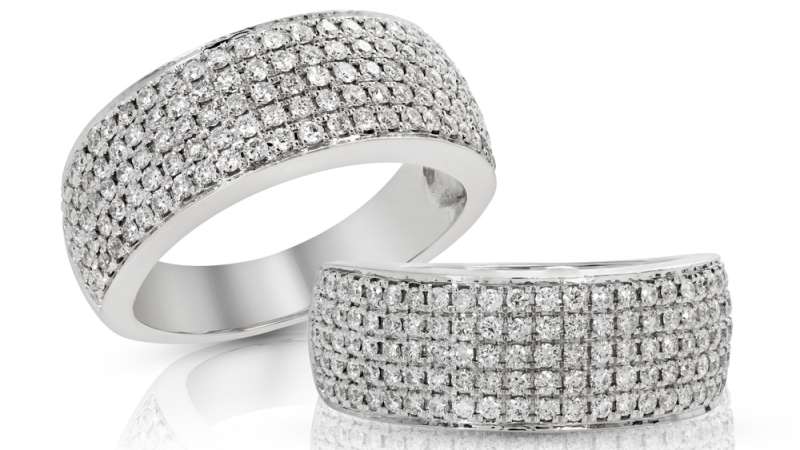
Best Rings For Pavé Diamonds
The pavé setting is predominantly used in rings and is not commonly seen in other types of jewelry. However, it’s important to remember that you’re not bound by trends and can choose any jewelry piece you prefer. Let’s explore the other jewelry items that can feature the pavé setting and pavé diamonds.
Bracelets and watches are popular choices for showcasing the pavé setting. Both these pieces require a significant number of pavé diamonds, making them a more substantial investment.
Watches, in particular, have gained popularity in recent years. People often purchase expensive watches and adorn them with small diamonds, creating a pavé setting. This trend places watches at the top of our list of jewelry items featuring the pavé setting.
Bracelets follow a similar pattern, although unlike watches, the pavé setting on bracelets may not cover the entire piece. Typically, the central part of the bracelet is adorned with pavé diamonds, while the rest retains the shine of the precious metals.
Now, let’s focus on rings—the most sought-after jewelry piece for the pavé setting. Rings offer the ideal size to accommodate a moderate number of diamonds, providing full coverage without exorbitant costs.
This is a key reason why rings are the most popular choice for the pavé setting. Additionally, the pavé setting has become increasingly popular for engagement rings, further emphasizing its appeal.
Engagement rings are renowned for their beauty, and the pavé setting perfectly complements this special occasion. Affordable, aesthetically pleasing, luxurious yet casual—the pavé setting aligns perfectly with what people desire in engagement rings.
Another factor that makes rings ideal for the pavé setting is their placement on fingers, which typically experience frequent movement. This allows each small diamond to catch ample light, individually shimmering while collectively creating a radiant display.
Now, let’s consider which types of rings are best suited for the pavé setting and which ones are less compatible.
Firstly, wider rings are more suitable. The pavé setting is often crafted with multiple rows—three, four, or five—requiring sufficient space to accommodate these diamonds.
However, if you prefer a narrower ring, some pavé settings allow for a single row of smaller diamonds on each side of the centerpiece. It’s important to note that it’s preferable to have a centerpiece in such cases.
When it comes to the choice of metal, platinum, silver, rose gold, and white gold pair exceptionally well with the pavé setting. While regular gold can also work, there are more favorable options available.
Precious metals with a silver or lighter color allow the diamonds to appear more cohesive, enhancing their collective brilliance.
If you’re seeking a ring with multiple larger diamonds in conjunction with a pavé setting, look for designs featuring one centerpiece and two side stones, with the remaining area adorned with the pavé setting. This combination effectively utilizes multiple larger diamonds alongside the pavé setting.
Fortunately, jewelers are well aware of these preferences. If you’re in search of a ring featuring multiple larger diamonds and a pavé setting, you’ll have no trouble finding a suitable design.
Lastly, it’s crucial to consider the reputation of the jeweler when purchasing pavé diamonds. Due to their small and delicate nature, securing pavé diamonds can present challenges, limiting the options for jewelers to secure them in place.
The amount of adhesive used to hold pavé diamonds is minimal. If the jeweler hasn’t used enough adhesive, you may encounter issues with diamonds falling out.
Some jewelers offer replacements for lost diamonds if you have insurance and it is determined that the loss is not due to your mishandling.
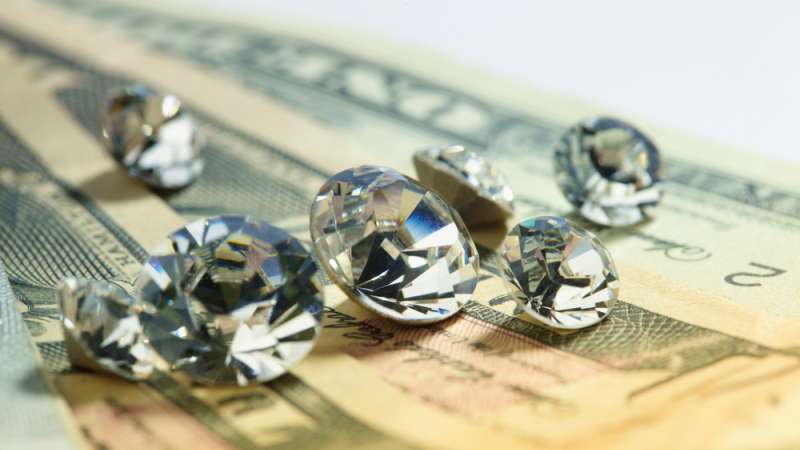
Pavé Diamonds – Price
Determining the price of pavé diamonds can be challenging as they are small and typically priced as a collective rather than individually. The total carat weight of the diamonds embedded in the pavé setting is a common factor considered in pricing.
For custom rings, it’s advisable to communicate your budget to the jeweler. They can guide you on the size of pavé setting that fits within your price range.
Prices for pavé diamonds start around $1,500 and can reach tens of thousands of dollars, depending on various factors involved in the ring.
If a ring includes a centerpiece that is part of the pavé setting, the price tends to be higher. The centerpiece diamond needs to be larger than the small diamonds in the pavé setting to create a noticeable contrast.
The choice of precious metal also impacts the price, particularly since the pavé setting requires ample space to accommodate the small diamonds.
As you can see, determining the exact price of a pavé diamond ring can be tricky. Generally, these rings are considered semi-affordable, influenced by the level of luxury and the total carat weight of the diamonds.
Pavé diamonds, especially the small ones, usually have a simple cut and embedding, which helps keep the price from skyrocketing.
However, it is possible to spend a significant amount on a pavé diamond ring depending on your preferences. For instance, a platinum ring with over two carats of small pavé diamonds may have a price tag close to $15,000.
Alternatively, opting for a more cost-efficient and minimalistic pavé ring can still result in an attractive piece that catches attention and leaves you feeling admired.
Fortunately, the small size of pavé diamonds means they don’t require a high clarity grade since imperfections are not easily visible. This can help save some money in that regard.
Color grade, on the other hand, holds more significance, especially if you’re willing to invest in a pavé ring where the centerpiece has a different color than the rest of the diamonds. Champagne diamonds, for example, complement the pavé setting beautifully, allowing you to allocate some of the saved funds from clarity to color.

Pavé Diamonds – Pros & Cons
Now, let’s delve into the strengths and weaknesses of pavé diamonds to help you decide if they’re worth considering. It’s important to note that these are not dealbreakers or exceptional qualities that should solely sway your opinion. Rather, they represent the positive aspects and aspects to be cautious about when considering pavé diamonds.
Please keep in mind that you are not obligated to agree with our viewpoint. It’s perfectly acceptable to have a different opinion, especially if you are new to this topic. Nonetheless, we hope to provide some helpful insights for those seeking guidance.
Pros of Pavé Diamonds:
- Affordability: Pavé diamonds are relatively affordable, considering the overall appearance they offer. The price tag associated with a pavé setting ring, typically rings, is quite reasonable. Despite the luxurious feel and aesthetic appeal of the pavé setting, the cost remains balanced in comparison to the value you receive. Additionally, if you desire a diamond setting that stands out and catches attention, pavé diamonds offer a cost-effective option.
- Authentic Look: Pavé diamonds exude authenticity, as they possess a distinct appearance unlike many other settings. While most diamonds are standalone gemstones in jewelry pieces, pavé diamonds present a unique approach. Although a pavé setting can include a centerpiece diamond, it is not a requirement. Instead, the pavé setting consists of numerous small diamonds, which adds originality and authenticity. This may not be considered a strength by some, but we perceive it as such since finding originality in a world filled with repetitive diamond settings can be challenging.
- Accessibility: Contrary to assumptions, pavé setting diamonds are easily accessible and readily available. Due to their affordability and authenticity, pavé settings have gained popularity among the general population. As a result, jewelers tend to stock a variety of pavé setting rings, aiming to meet the demand. While some may view this as a disadvantage, we will discuss the potential drawbacks in the next section.
- Ease of Repair: As mentioned earlier, pavé setting jewelry is easy to fix. Some jewelers even offer insurance coverage for pavé setting jewelry in case a diamond or two fall out. Fortunately, the small size of pavé diamonds makes repairs and replacements relatively straightforward and cost-effective. In the event of a diamond falling out, most jewelers can easily reattach it using adhesive. Additionally, the sturdy nature of the precious metals used in pavé setting rings provides stability and support, minimizing the risk of breakage.
Cons of Pavé Diamonds:
- Common Setting: As previously mentioned in the pros, pavé setting rings are quite common and can be seen frequently while walking around. This may be a disadvantage for those seeking a unique and eye-catching ring that stands out from the crowd. However, it’s challenging to find an affordable, widely available, and rare setting that checks all three boxes. We recommend considering your priorities and settling for what matters most to you.
- Diamond Loss Risk: One prominent issue inherent to pavé settings is the potential for diamonds to fall out. We briefly touched on this earlier, but let’s explore it further. If the jeweler responsible for crafting your pavé setting ring fails to apply enough adhesive, there is a higher likelihood of diamonds coming loose from the jewelry. While this is a common occurrence, there is little you can do to prevent it. It can be frustrating, but it’s essential to understand that the price of a pavé setting ring does not vary significantly among cheaper jewelers. Therefore, it’s advisable to purchase your rings from reputable jewelers. In the event of a diamond falling out, it’s recommended to retrieve and save the diamond, if possible, and promptly seek professional repair. This problem can be resolved at an affordable price, so there’s no need to worry.
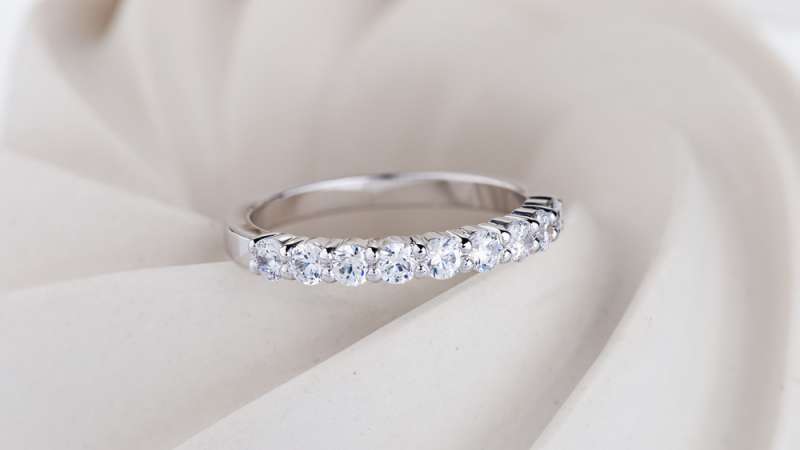
Conclusion
Now that we’ve covered a comprehensive overview of pavé diamonds and the pavé setting, let’s summarize everything we’ve learned about these diamonds and the setting itself.
First and foremost, it’s important to note that the pavé setting is exceptionally beautiful and original. Pavé diamonds make a lasting impression due to their luxurious appearance, yet they remain surprisingly affordable. This affordability explains why pavé settings are commonly seen.
While this accessibility may pose challenges for some individuals seeking a more unique option, we highly recommend the pavé setting to anyone who is unsure about their preferences but desires a diamond ring.
We hope we have sparked your interest in this setting and have made it easier for you to educate yourself about pavé settings and pavé diamonds.


